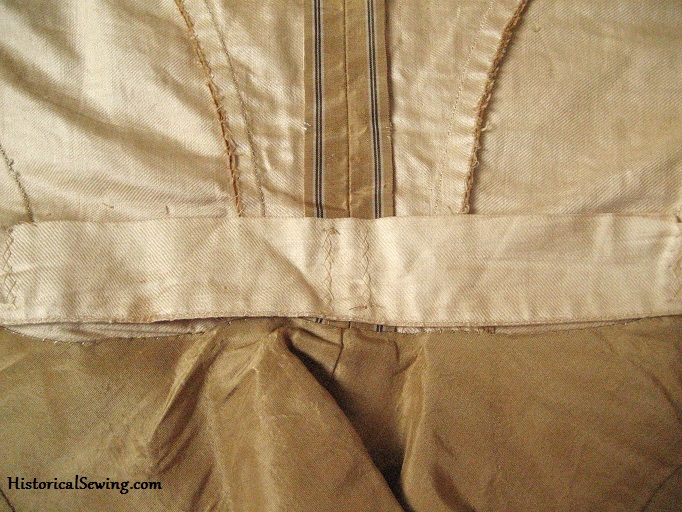
The inside of antique bodices.
If you sew historical costumes you know THAT is what you want when you research. How did they do it? Where and how is the boning put in? What is that underlining fabric?
Any chance we get we study existing bodices from our favorite era. If we want to produce the fashions our ancestors wore then studying them is how to start.
So in your research you probably came across a wide range of bodices that had a bit of twill or ribbon tacked to the inside at the waist level. Sure, it looks functional with a hook on the end, but why is it there? What’s its purpose? Let’s look at bit more at this fully functional piece.

It’s sad in our current supply of modern clothing that waist tapes have gone the way of the couture do-do bird. Even as “recent” as the 1950s and 60s, everyday dresses had waist tapes tacked inside. But somewhere in the search for loose comfortable clothing this support element disappeared from contemporary consciousness.
You’ll find a few reasons for why a waist tape was put into a bodice, the main one being to keep the bodice in place around the body and prevent it from shifting. The tape is nearly always tacked at the center of the bodice, and with the tape wrapping around the body the bodice doesn’t stand much of a chance to go a-wandering.
In dresses, by firmly tying the dress around the waist it takes pressure off the shoulders and moves some of the weight of the skirt to the waist. Less stress on any area of a garment means less risk of rips and tears (a good thing!).
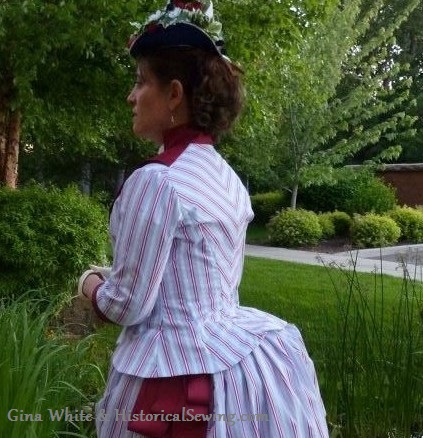
For front-closing, Victorian bodices from the 1850s to the 1890s, a waist tape helps keep the back of the bodice right up against the body, thereby assisting in the small waist appearance (what we want right?!). The bodice back is pulled tight to the figure with the tape that is fastened at the front.
Use this bit of knowledge as a clue to getting the historical silhouette right.
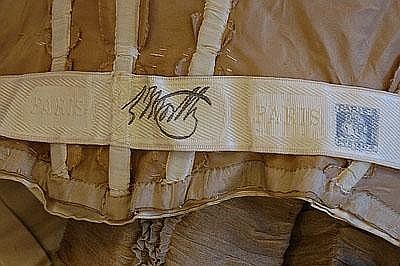
What to Use for a Waist Stay Tape
The originals we see most have a very fine example of a waist tape. Goodness! It looks like a cross between ribbon and twill tape. And most of them are. Waist tapes need to be sturdy and tightly-woven – they get lots of tension.
Originals were printed with the couture fashion house name. (Worth labels, anyone?) The tape was used as the identifying tag in the garment just like the labels in our modern clothes today. Only the designer houses had printed tapes.
For historical reproductions a basic 1″ wide cotton twill tape is perfect. I don’t recommend less than a 3/4″ width, and there’s no need to go wider than 1.25″.
And cotton really is preferred. I know polyester tapes (such as Wrights) are found everywhere. But as with all our materials in making period clothes, the lowly waist tape should also be from natural fibers. Cotton petersham ribbon works very well.
Cotton is common but you can find linen tapes that will work too, silk only if you care to spend money on a silk twill or grosgrain ribbon. 🙂 In a pinch, cut a double layer straight strip of twill fabric and make into a soft belt.
And don’t use bias! Duh. It will stretch out and not give the proper support that waist tapes are made for.
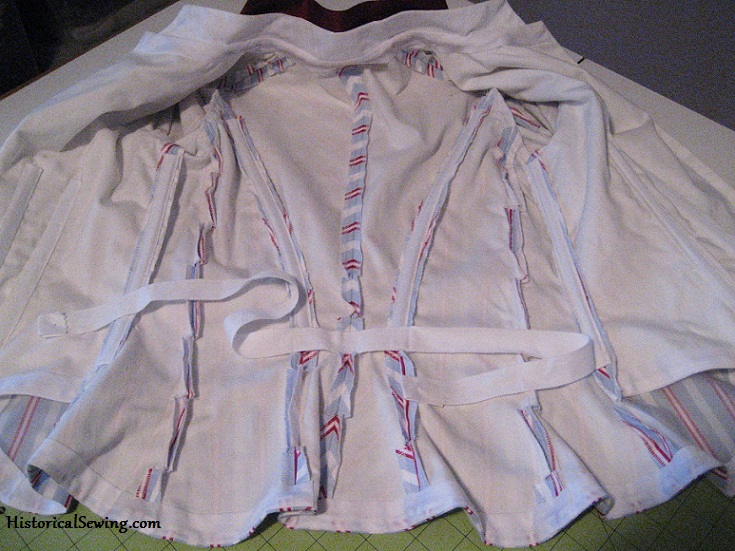
How to Sew in a Waist Stay Tape
Our ancestor dressmakers knew what they were doing. So following their example let’s tack our waist tapes at the same points.
For starters, the waist tape will go around the inside the bodice at… wait for it…. the waist area. (Oy! That was unexpected.)
But seriously, don’t think that it needs to go higher or lower or wherever. It gets tacked to a few seams on the inside right where the bodice sits at the waistline. Remember the tape holds the bodice to the body; the waist is a focal point of the entire dress. So the tape secures it to our smallest area.
Cut your tape the same length of your waist measure over all your undergarments, corset and skirt waistband. Add an inch or more for overlap and closure and any other little bit for finishing the raw edge.
I like to halve my tape then pin to the center back seam of the bodice. I’ve seen tapes tacked only to the side back seams and some tacked to the side backs AND the center back seam. Attach as you need for proper fit and alignment of the bodice.
Pin and tack tape to the side seams. Again, some originals will have the tapes tacked to the front darts as well, but for us it depends on if we need to hold the garment close to our figures in front. You may only need tacks at the back and sides.
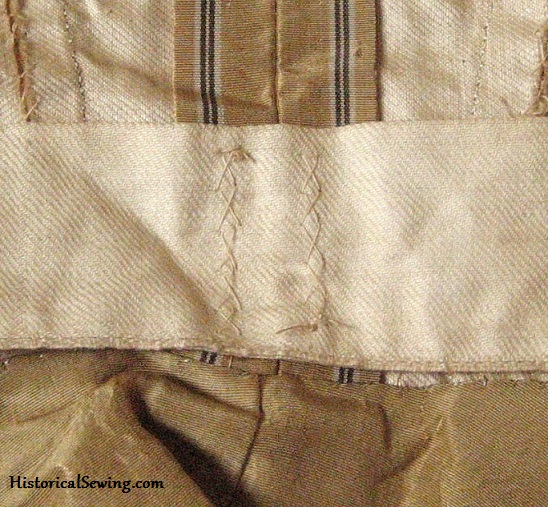
Use catch stitches or cross stitches in a row over the width of the tape securing to the bodice seam allowances. If you have bone casing on those seams tack to that.
Put the bodice on over your corset and undergarments. Wrap the tape ends around to the front and cross over. Sew on two sets of hook & eyes or one hook & bar to close. It needn’t be super tight but must be snug to keep the bodice in place.
And don’t feel bad if you have to rip out some of the tacks and move the tape up or down. (I’ve done it a few times.) It’s difficult to know exactly where the waist is on the bodice versus the best placement of the tape to hold it to your figure over your skirts. Fortunately there’s only a few tacking points. 🙂
Do you put waist tapes into your historical bodices? Can you tell the difference they make than other bodices that don’t have them?

I am making a 1912 day dress from a vintage pattern and had been puzzling how to apply the stay since the directions are limited. I have done earlier bodices but this helped clarify things! Thank you!
Yay! You are quite welcome. 🙂
Where was this tape made/manufactured? Were the mills in New England making this?
I’ve not delved into the manufacture. From my research it would most likely be made from local mills, in whichever country the final consumer use would occur. Exported goods were probably around too.
Thank you for this!! I don’t see costumes but really trying to create my own garments. A lot of these historical techniques are what makes tailored and haute couture garments so well constructed. But this gets glossed over in most resources for home sewers. I am slowly learning individual techniques and materials, how, where and why they work to better understand garment construction. Your blogs and Bernadette Banner have been great inspirations and teachers!
Oh, so happy to hear they are helpful to you, Sai! Cheers for your sewing journey. 🙂
Thank you so much. I am new to the victorian attire and love the bustle time period. I have been ordering polonaise tops and couldn’t figure out why it was sagging in the back. This will completely fix my look. It’s so easy too for a novice sewer like myself. Thank you. Will this work for one piece dresses too?
Yes! And for other time periods too – even modern dresses, if you please. 🙂
It’s uncanny. Whatever I am doing, whichever point in construction I happen to be, however flummoxed the project has me–there you are with the solution! Honestly, Jennifer, I’m ready to call you my creative guardian angel.
Waist tapes away!
What a helpful article about the waist tape! I am currently in the design phase of an 1880’s jacket, that will of course be flat lined, boned, and then I want to line it – I just can’t abide seeing all the internal workings of an unlined garment 🙂 I’m wondering how to manage the waist tape AND line the jacket. Would the tape be tacked down to the underlining, and then then jacket lining placed on top of it, or would I line the jacket, then last apply the waist tape? If the later, would the tacking stitches go through the lining to the underlining, or the seam allowances of the garment layer? So it’s a layering issue? Am I over thinking this? haha, probably yes! (Oh, I just wanted to say the pink silk jacket illustrations really helped with the back pleat issues too!) Thanks so much for all the handy information. Sharon
I’d make up the bodice just like I show here with the bone casings and waist tape. Then, add in a full lining to cover everything. You can read more about linings in my article here.
Hmmm…I think this might be what I’m missing. And solve the problem I’m having with the bodice just not sitting right.
It’s not just period garments that a waist stay helps; Threads had an article about inaugural gowns and a waist stay was a big part of the fit and comfort of them, especially sleeveless ones.
You are the BEST 19th century tutor and designer.
I learned all about the glory of the waist tape last summer, making a 1956 Vogue dress for a fun Mad Men photo shoot. The bodice consists of less than a yard of semi-sheer chiffon in sky blue, with a bright, almost abstract floral print. The skirt is about a mile of the same fabric, gathered in tight to the teeny waistband. Without the waist tape to attach the skirt to, the bodice could never take the weight, or at least be dragged down, as opposed to floating nicely about the shoulder gathers. Ever since then I have sworn by the power of the waist tape – I’m even considering putting one in a medieval velvet kirtle… It could get heavy. 🙂
Excellent!
Perhaps a bit more about strategy (placement of hooks) for hooking skirt to bodice? And attaching underskirt vs overskirt to bodice?
Thanks!
Ok. Have you seen this video tutorial yet? It’s on the matching skirt/bodice hooks.
Yes, three cheers for the waist tape! However, I place the mid-point of the tape on the right Side Back seam rather than the Center Back seam of the bodice, thereby causing the tape’s front fastening to meet at left-of-center of the bodice front. It’s just a tiny reduction of bulk at center front, but with the corset busk at that spot, as well as buttons & buttonholes or hooks & eyes — hey, any little bit helps! Why at right side back rather than left side back? Because I am right-handed and I find fastening the tape at left-of-center easier than right-of-center. Left-handers likely would prefer the opposite.
Well, of course that makes sense! Thanks for the tip Diane. 🙂
I’ve only made one Victorian dress so far, but I made sure I put in a waist tape, the difference it makes is amazing. I wore it once without fastening the tape and it kept shifting upwards resulting in a quick loo trip to fasten it, not a problem after thar. It’s something I’ll definitely do again.
How very timely! I had just done a web search for “waist stay” so that I could use one in my sister’s 1858 basque bodice~the mock-up bodice was shifting up as she moved. I didn’t want her to have to tug it down all the time. I have an ‘issue’ with tugging and pulling clothes into place once one is dressed: one shouldn’t have to! I especially like your photos; it helps clarify the descriptions. THANK YOU.
I’ve been wondering if these were used in dresses with back closure as well (ball gowns etc.). Or would those be constructed so tight fitting that one isn’t necessary?
The waist stays can definitely be put into a back closing bodice as well. You’ll just need someone to help fasten you up. 🙂
Thank you for asking this question! I’m planning to alter some ready-made dresses & jackets I own for a better fit and to make them easier to wear and one of them is a cuirass ball gown bodice that has a back hook & eye clossure. I thought it was possible but a second opinion helps to quite the doubts. Again, thank you Koleha & Jennifer!
A waist stay makes so much difference to a garment I can’t believe that anyone would not spend that little extra time to put one in. In a bodice it holds everything in place and in a dress it takes the weight of the skirt. I made a couple of 1911 dresses and used waist stays in both- in the day dress there was a little of the Gibson girl blousing left over in the style which did not work at all until I added the waist stay to support the skirts and allow the bodice to blouse over the waistband. The evening dress would have been a complete failure without one- the weight of the skirt (silk, interlining, overlay, train) would have been too much suspended form the thin silk and lace at the shoulders.
Is this also why waist tapes are used in modern corsets? I’ve seen several patterns and tutorials that talk about it and have never quite been able to figure out the purpose before. This is the first article that’s said anything about why to use a waist tape, and I thank you for it–and on my next Victorian garment, I absolutely will use one! Not sure on the Elizabethan costume; I have to check and see if it would be appropriate first…
The stay tape in corsets (quite a common thing actually) is to reinforce the waist area (of course) because that’s the part that gets the most stress in cinching in over and over. The corset tape helps keep the waist to it’s original measurement.
Thank you! I will definitely use a waist tape when I make my Victorian corset, then. I have lots of waist to cinch, after all!